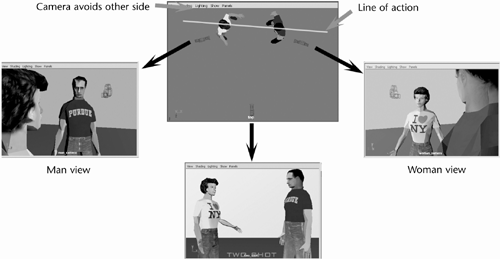Directing 101
| |
| Having learned about camera placement from a still photographer's point of view, now add the dimension of time. Objects can move and change shape or color over time, and the camera can move around the scene. You can also edit together several sequences with cuts or dissolves between different camera passes . At this point, you are in the realm of the movie director. Film direction has some rules that are good to know for shooting 3D action. Cutting and the "Line of Action"Generally, when starting a scene, the viewer needs a frame of reference. Directors usually provide it with what's called a master shot , a brief shot of the majority of the setting to give an idea of the layout. If characters will interact, the master shot usually begins with the two shot , a view of both characters that establishes their relative positions . If a single character is moving around, the full-body shot is referred to as a wide shot . A medium shot shows a character from waist to head, and a medium closeup , from chest to head. The closeup includes the neck to the top of the head, but the extreme closeup crops from above the eyes to below the lips. These descriptions apply to humans , of course; your alien character's body and facial parts might be in quite different places! At least you have a starting point to describe the shot sequence for telling your story, though. note The line of action refers to maintaining the camera on one side of the scene action to avoid disorienting the viewer. As in a stage play where the audience is fixed on one side of the action, it is easy to confuse the viewer if the camera crosses the line of action between characters, as shown in an establishing shot. For example, if two characters are conversing , the camera will stay on one side of an imaginary line between the characters, as in Figure 1.11. Figure 1.11. An illustration of line of action. Scene MotionA problem that animators of all kinds have is imparting mass and momentum to characters. In life, objects and people rarely start or stop moving instantly, but when they do stop abruptly, things attached to them often wobble or fall off. None of this happens automatically in animation, however, so you must remember the dynamics of real-life motion and simulate it with the motions you create. In cartoons, this motion is often exaggerated: A character's height and width vary radically as she walks, or she spreads out and loses height when hitting the ground. Center of gravity is also important. For example, if a character rears back, it puts a leg out as a counterbalance; otherwise , it would fall over. Animators often act out their characters' motions and film them for reference to remember these subtle but important facets of real-world movement. Camera MotionThe camera can move as well, and in a 3D program there are no limitations ”it can fly through keyholes, move as fast as a jet and stop instantly, or rotate in place at 100 spins per second. Unless you want your human audience to become upset or ill, however, you should adhere to the same principles as real-life camera operators. If you rotate in place, you must move very slowly, for example. Don't roll (tilt) the camera in relation to the horizon unless you are doing a special effect, like a fighter jet or roller coaster point of view. As an animator, you should give the camera mass so that it doesn't start or stop "on a dime." The camera should go from fixed to moving or rotating with gradual acceleration, and go from moving or rotating back to a fixed position with gradual deceleration. You can put the camera on a path , a curvy line that passes through your scene like a roller-coaster rail. Be careful not to force the camera to look forward, though, or the results will be a whiplash experience for your viewers . Instead, leave the camera rotation as floating so that the virtual viewpoint is moving, but its rotation is smooth and fluid. |
EAN: 2147483647
Pages: 201
